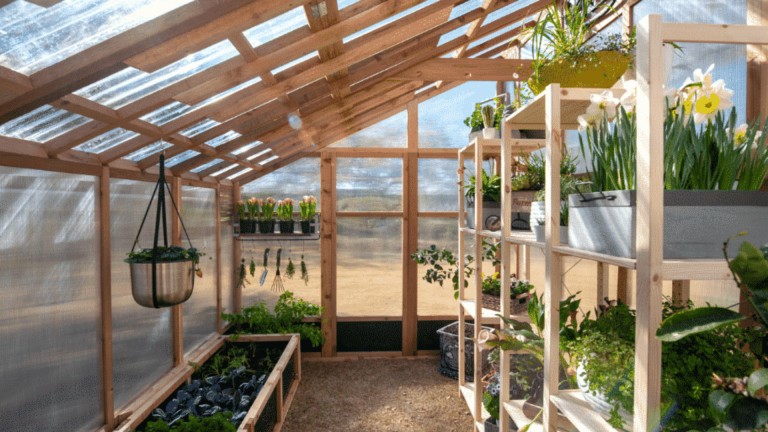A tea garden is a small area where you can grow plants used to make tea. These exotica plants may include herbs, flowers, or shrubs, and they can thrive in a backyard, on a balcony, or even in pots placed near sunlight.
Starting a tea garden doesn’t require a lot of space or experience—just a bit of planning and care. In this article, you’ll learn which plants to choose, how to grow and maintain them, and how to use them to prepare fresh, homemade tea.
If you’re unsure about where to begin, this guide provides clear steps and practical advice to help you get started. The information is based on trusted gardening practices, so you can feel confident as you begin.
Whether you want to grow a few calming herbs or a wider variety for different flavors, this guide will give you the knowledge you need to create a productive and rewarding tea garden at home.
What Is a Tea Garden?
A tea garden is a small, personal garden space used to grow plants meant for tea. It can be set up in a backyard, balcony, or even on a windowsill. The goal is to produce leaves, flowers, and roots that can be steeped in hot water to make tea.
These gardens are simple and useful. They offer fresh ingredients and a calming hobby. Many people enjoy the daily routine of picking leaves and brewing a fresh cup of tea.
A tea garden usually holds a diverse mix of plants. Some offer calming effects, while others help with digestion, alertness, or immunity. Each plant brings a unique flavor and health benefit.
Benefits of a Tea Garden
A tea garden gives more than just herbs. It can improve your health, lower costs, and reduce waste. You also learn useful skills while enjoying the process.
- Health: Fresh herbs like mint, chamomile, and lemon balm can support sleep, digestion, and relaxation. You know exactly what’s in your tea—no added chemicals or flavors.
- Cost-Effective: Buying tea herbs can add up over time. Growing your means you spend less in the long run. A few seeds can give you months of tea.
- Sustainable: Homegrown tea reduces packaging, shipping, and plastic waste. You only pick what you need. It’s a simple way to be more eco-friendly.
- Educational: Growing tea teaches you about soil, sunlight, and plant care. It’s a hands-on way to learn. Ideal for both children and adults who appreciate nature.
True Tea Plant: Camellia Sinensis
Camellia sinensis is the plant used to make all true teas—black, green, white, and oolong. The type of tea depends on how the leaves are processed, not on the plant itself.
This plant has small, dark green leaves and can grow into a shrub or small tree, though it’s usually kept trimmed low for easy picking.
With the right care, tea plants can live for many decades or even over a hundred years. They grow best in warm, humid climates with steady rainfall, temperatures between 55°F and 90°F (13°C–32°C), and well-draining, acidic soil.
Types of Herbal Plants
Herbal plants are full of natural compounds. Some help with digestion, others fight infections, and some can calm the mind. People use them in teas, oils, creams, and even capsules.
1. Mint
Mint tea is made from the leaves of spearmint or peppermint plants. It has a cool, refreshing taste that helps relax the muscles in the stomach. People often drink it after meals to relieve gas, bloating, or cramps. Mint tea is also known to ease tension headaches and freshen breath.
2. Passionflower
Passionflower tea is made from the leaves and sometimes the flowers of the plant. It has a mild, grassy flavor and is mainly used to calm the mind and reduce anxiety. Some people drink it before bed to improve sleep or ease restlessness. It’s also thought to help with nervous tension and support overall relaxation.
3. Rose Hips
Rose hip tea is brewed from the small fruit that grows after a rose flower fades. It has a tangy, citrus-like flavor and is rich in vitamin C, which supports the immune system. People drink it to help ward off colds or boost their energy. Some also enjoy it for its soothing effects on digestion and overall wellness.
4. Lemon Balm
Lemon balm tea is made from the soft, green leaves that have a lemon-like scent. It’s a gentle herb used to calm the nerves, lift mood, and ease stress. Many drink it to help with anxiety or light insomnia. It may also support digestion and sharpen mental focus in small amounts.
5. Chamomile
Chamomile tea is one of the most popular herbal teas, made from small, daisy-like flowers. It has a sweet, floral flavor and is often used to promote sleep and calm the mind. It can also help with mild pain, such as menstrual cramps or an upset stomach.
6. Echinacea
Echinacea tea comes from the flower buds of a purple coneflower. It has a bold, earthy taste and is mostly used to boost the immune system. Many people drink it at the start of a cold or flu to help shorten the illness. It may also reduce inflammation and support the body’s natural defenses.
7. Milk Thistle
Milk thistle tea is made from the spiky purple flower buds and seeds of the plant. It’s best known for protecting the liver and helping the body clear toxins. The flavor is slightly bitter, so it’s sometimes mixed with mint or lemon. Many people also use it as a gentle detox drink to support overall health.
8. Angelica
Angelica tea is brewed from the plant’s thick roots, which have a strong, spicy flavor. It’s often used to ease gas, indigestion, or stomach cramps. This tea may also help relieve menstrual pain and improve circulation. Some cultures use it in small amounts to boost energy and appetite.
9. Catnip
Catnip tea is made from the fuzzy green leaves of the catnip plant. While cats go wild for it, the effect on people is calming. It’s used to ease nerves, settle the stomach, and sometimes help with fevers or colds. The flavor is mild and minty, making it easy to drink.
10. Raspberry
Raspberry leaf tea is brewed from the leaves of the red raspberry bush. It’s often called a “woman’s tea” because it supports the female reproductive system, especially during pregnancy. It can help tone the uterus and ease menstrual cramps.
11. Lavender
Lavender tea is made from the plant’s fragrant purple buds. It has a strong floral flavor and is widely used to calm the nerves, reduce anxiety, and support sleep. It may also help relieve headaches or ease digestion. Drinking it in small amounts can be very soothing, especially before going to bed.
12. Nettle
Nettle tea is made from the plant’s young green leaves, which are rich in iron and other nutrients. It’s often used to support detox and help with seasonal allergies. The taste is earthy and grassy. Nettles also support joint health and may help with fatigue or anemia when taken regularly.
13. Red Clover
Red clover tea comes from the bright pinkish-red flower buds. It’s used to help cleanse the blood and balance hormones, especially during menopause. The tea may also support heart and bone health. It has a light, slightly sweet flavor and can be mixed with other herbs.
14. Dandelion
Dandelion root tea has a deep, roasted flavor similar to coffee. It helps the liver filter out toxins and improve digestion. It can also act as a gentle diuretic to reduce water retention. Some people drink it daily to improve skin and support healthy metabolism.
15. Linden
Linden flower tea is made from the blossoms of the linden tree. It’s gentle, sweet, and often used to calm the mind and relax the body. Linden tea is helpful for digestion, headaches, and light colds. It’s mild enough for children and works well as a bedtime tea.
16. Lemongrass
Lemongrass tea is brewed from its long, thin stalks. It has a clean, lemony flavor and is beneficial for easing digestive issues such as bloating or cramps. It may also help reduce anxiety and support healthy cholesterol levels. Many people enjoy it iced in warm weather for a refreshing herbal drink.
Planning Your Tea Garden
A tea garden is a peaceful space where you grow herbs and plants used for tea. Good planning makes it easier to grow healthy plants. You’ll need to think about sunlight, soil, and how to lay out your space.
Choosing a Location
Before planting anything, take time to study your space. The right location can make a big difference in how well your tea plants grow. Think about light, soil, and how much room each herb will need. A good setup now saves work later.
Sunlight: Most tea plants need 4–6 hours of sunlight daily. Morning sun is often best. Too much afternoon sun can quickly dry out leaves. Check how much light your garden spot gets each day.
Soil: Tea herbs prefer well-draining, slightly acidic soil. Add compost to improve texture if your soil is heavy clay; mix in sand or peat moss. Raised beds can also help with drainage.
Space: Use containers for invasive plants, such as mint or lemon balm. They spread fast and can take over—place containers where roots won’t creep into other beds. You can also bury pots in the ground to blend them in.
Garden Layout Tips
Planning your layout helps your garden grow better and look nicer. It also makes caring for plants easier. Focus on grouping, spacing, and overall appearance. A simple plan keeps things neat and efficient.
- Group by Needs: Place plants with similar water and light needs together. This saves time when watering. Overwatering sun-loving plants can cause rot. Keeping groups consistent makes care easier.
- Accessibility: Make sure there’s room to move between plants. You’ll need space to water, prune, and harvest. Avoid planting too close together. Use stepping stones or narrow paths if required.
- Aesthetics: Mix colors, textures, and plant heights for a pleasing look. Place taller plants, such as lavender, in the back or center. Use shorter ones, such as thyme, around the edges. Flowering herbs add beauty and attract bees.
Growing and Caring for Tea Plants
Once your tea garden is planted, you’ll need to care for it regularly. Healthy soil, proper watering, and gentle upkeep help herbs thrive. Simple steps, such as pruning and pest control, help keep plants growing strong. A little effort goes a long way.
- Soil and Watering: Tea plants like soil that drains well and holds nutrients. Add compost to enrich the soil and promote steady growth. Water often enough to keep the soil moist but never soggy.
- Pruning and Maintenance: Prune your plants often to help them grow fuller and bushier. Trim just above the leaves to encourage the growth of new stems. Pull weeds before they spread, since they steal water and space.
- Pest Control: Pests can harm tea herbs, but you don’t need harsh sprays. Use neem oil or insecticidal soap to get rid of bugs gently. You can also plant basil or marigolds nearby to scare off unwanted insects.
- Harvesting and Using Your Tea Plants: Once your plants are grown, it’s time to use them. Picking at the right time keeps flavors fresh and strong. You’ll need to dry and store them properly. Then, you can brew a tasty cup anytime you like.
- When to Harvest: Pick the leaves when they are young and tender. That’s when the flavor is the best. Don’t wait too long, or the leaves may turn bitter. For flowers, harvest just before they fully bloom. This is when they hold the most scent and oil.
- Drying and Storing: After picking, you can hang herbs upside down in a dark, cool place. This helps them dry slowly and evenly. A food dehydrator works, too, if you want it done faster.
- Brewing Tips: You can use herbs fresh or dried when making tea. Dried ones often have a stronger taste and last longer. To brew, steep the leaves or flowers in hot water for 5-10 minutes. Cover the cup while it steeps.
Conclusion
Creating your own tea garden is a simple and fulfilling project. In this blog, we walked through each step—from choosing the right location and planning your layout to caring for your plants and knowing when to harvest.
You also learned how to dry, store, and brew your herbs for the best flavor. We explored the benefits of having a tea garden, including better health, lower costs, and learning new skills. Whether you have a large yard or a small balcony, you can start with just a few herbs and build from there.
Gardening doesn’t have to be complicated. With a little time and care, you’ll have fresh tea right at your fingertips. Now that you know the basics, you’re ready to grow, harvest, and enjoy your own homegrown blends—one cup at a time, starting today.
































